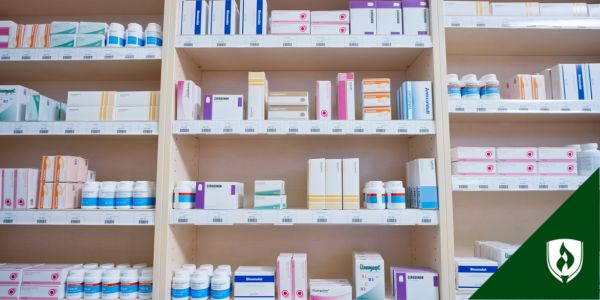How To Become a Pharmacy Technician
11/25/2025

If you’re interested in healthcare and want to play more of a hands-on role in helping others, becoming a pharmacy technician may be the next step for you. Pharmacy technicians typically support1 pharmacists in preparing medications, maintaining accurate records, and communicating with patients while ensuring safe, efficient pharmacy operations.
Through Rasmussen University’s Pharmacy Technician Certificate program,2 you may gain the education and practical experience designed to help you prepare for this essential healthcare role. This fully online program is designed for flexibility and built around real-world pharmacy skills.
What You’ll Learn in the Pharmacy Technician Program
The Pharmacy Technician Certificate program2 provides a solid foundation in both the science and practice of pharmacy. You’ll learn skills that may prepare students to accurately interpret and fill prescriptions, use pharmacy software to manage and stock medications, and apply your understanding of medical terminology, pharmacy law, and ethics in every aspect of patient interaction.
Your courses will help you build knowledge in areas such as:2
- Preparing and Handling Medications: Reading medication orders, filling prescriptions, preparing labels, and performing inventory functions.
- Safety and Quality Assurance: Understanding the required safety and infection-control policies and procedures.
- In-Demand Technical Skills: Gaining experience in using pharmacy software and technology to manage the pharmacy and process medications.
- Professional Practice Skills: Typically ensuring patient confidentiality with a high level of customer service support both at pharmacy counters and over the phone.
These skills are central to effective pharmacy practice, which may help in your work alongside pharmacists and patients.
Fully-Online Flexibility at Rasmussen University
Rasmussen’s fully-online program2 allows you to complete your pharmacy technician courses from anywhere. Coursework combines interactive lessons, simulations, and virtual labs that replicate real pharmacy workflows.
As part of your training, you’ll complete a Pharmacy Virtual Practicum, a simulated experience that helps you apply classroom learning to authentic pharmacy scenarios to prepare for examinations that meet state laws.
Typical Career Paths for Pharmacy Technicians
Upon completion, graduates may gain the knowledge and skills relevant to retail or clinical pharmacy settings, where pharmacy technicians typically3 work under the supervision of licensed pharmacists to assist with medication preparation, inventory management, and compliance with state and federal regulations.
Pharmacy Technician Course Details at Rasmussen University
The Pharmacy Technician Certificate program at Rasmussen University totals3 38 credits, which include developmental, general education, and core courses designed to help prepare students for the national pharmacy technician certification exam (PTCE®) and real-world pharmacy practice.
Developmental Education Courses (as needed)
- Reading and Writing Strategies – 4 credits
- Practical Math – 4 credits
General Education Courses – 8 credits total
- Introduction to Communication* – 4 credits
- Structure and Function of the Human Body* – 4 credits
Core Courses – 30 credits total
- Career Development* – 2 credits
- Customer Service in Healthcare – 1 credit
- Medical Terminology – 4 credits
- Medical Law and Ethics – 4 credits
- Foundations of Pharmacy Practice – 4 credits
- Pharmacy Calculations – 4 credits
- Pharmacology for Technicians – 4 credits
- Sterile and Non-Sterile Compounding – 2 credits
- Pharmacy Technician Capstone – 3 credits
- Pharmacy Virtual Practicum – 2 credits
*Self-directed assessment options available for select courses.
The program is structured to help you feel fully prepared for certification and day-to-day pharmacy responsibilities.
Pharmacy Technician Licensure and Certification
This program is designed to help prepare2 students for the national pharmacy certification and state registration requirements where applicable.
Program completion may make you eligible to sit for the Pharmacy Technician Certification Exam® (PTCE®), administered by the Pharmacy Technician Certification Board® (PTCB®). Passing the PTCE may qualify you to apply for certification as a Certified Pharmacy Technician (CPhT), an industry-recognized credential valued by many employers.
While most states require certification or registration to work as a pharmacy technician, requirements vary. Rasmussen University helps students understand the state board guidelines that may apply to their location and offers information on how to meet those requirements.
The program meets or exceeds the educational requirements for professional licensure or certification in most states, although Rasmussen recommends that you verify details with your state’s licensing department.
Before beginning your Pharmacy Retail Practicum, you may need to complete certain prerequisites, including background checks, health clearances, and immunizations. These steps align with state laws and healthcare facility requirements, ensuring patient and student safety.
Typical Continuing Education Opportunities
After earning your Pharmacy Technician Certificate, you may choose to continue2 your pharmacy education by pursuing Rasmussen University’s Health Sciences Associate’s degree. Your completed coursework can count toward that next credential, providing a path for continued professional development.
This stackable credential model allows you to build on your foundation without starting over, giving you options to advance your education on your schedule.
Why Choose Rasmussen University
- Accredited and Nationally Recognized: Rasmussen University is accredited by recognized national accrediting bodies and has been providing career-focused education for more than a century.
- Flexible and Accessible: The online format allows you to start anytime and complete coursework around your other responsibilities.
- Supportive Learning Environment: From financial aid options to dedicated academic support, Rasmussen is focused on helping you succeed.
- Comprehensive Curriculum: Every pharmacy technician course aligns with industry standards and the expectations of the Pharmacy Technician Certification Board.
Take the Next Step Toward Becoming a Pharmacy Technician
Pharmacy technicians play a vital role in ensuring patients receive safe, accurate, and effective medication support. Rasmussen University’s Pharmacy Technician Certificate program2 provides a structured, flexible way to prepare for certification, gain practical knowledge, and contribute to effective patient care in retail or clinical pharmacy settings.
If you’re ready to begin, explore the Pharmacy Technician Certificate program2 today and take your next step toward pursuing a pharmacy technician career path.
The Pharmacy Technician Certification Exam® is a registered trademark of the Pharmacy Technician Certification Board, Inc. (non-profit corporation; DISTRICT OF COLUMBIA, USA)
1Bureau of Labor Statistics, U.S. Department of Labor, Occupational Outlook Handbook, Pharmacy Technicians, at https://www.bls.gov/ooh/healthcare/pharmacy-technicians.htm#tab-2 (accessed October 27, 2025). Employment conditions may vary.
2Rasmussen University, Pharmacy Technician Certificate Program, https://www.rasmussen.edu/degrees/health-sciences/pharmacy-technician/certificate/ (accessed October 27, 2025).
3Rasmussen University, 2025–2026 Academic Catalog, https://rasmussen.dcatalog.com/v/2025-2026-Catalog/?page=55 (accessed October 27, 2025).



